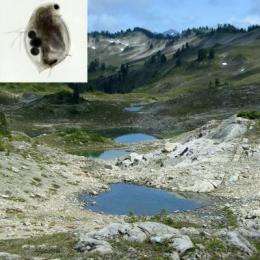Forget the Coppertone: Water fleas in mountain ponds can handle UV rays

Some tiny crustaceans living in clear-water alpine ponds high in Washington state's Olympic Mountains have learned how to cope with the sun's damaging ultraviolet rays without sunblock – and with very little natural pigmentation to protect them.
In fact, in laboratory tests these water fleas, about the size of fruit flies, withstood UV rays much better than the same species of flea taken from a pond less than a mile away, where the water was murkier and thus offered protection.
"The ponds pretty much look the same to us, but the environments are very different for the animals that live there," said Brooks Miner, a University of Washington doctoral student in biology, whose findings are published Oct. 13 in the online edition of the United Kingdom's Proceedings of the Royal Society B. Coauthor is Benjamin Kerr, a UW assistant professor of biology and Miner's doctoral adviser.
"Through their behavior, the Daphnia in the darker ponds can choose a deeper environment where there is no ultraviolet radiation, but the animals in the clear ponds don't have that choice," he said.
Miner conducted field sampling of water and zooplankton from several ponds at 4,200 to 4,800 feet of elevation in the Seven Lakes Basin of Olympic National Park. The samples were gathered from July through September in 2006 through 2009, after winter snow had melted and the water was beginning to warm enough for zooplankton such as the species Daphnia melanica to survive.
Daphnia from ponds below the tree line were protected from the sun because the water was made darker when surrounding vegetation fell into the water, starting a process similar to what happens in a steeping cup of tea. Water in ponds above the tree line was nearly crystal clear, Miner said, so the fleas there did not receive the same protection from the surrounding water. When the fleas were subjected to UV light in the laboratory, those from the clear ponds survived the best.

The biggest surprise, Miner said, was that the water fleas had very little melanin, a protective pigment found in most animals. He noted that fleas from other habitats that have melanin grow at a slower rate than those without it, so the water fleas in the Olympic Mountains apparently evolved less-costly means to deal with UV radiation.
"It could be that they evolved to use other strategies because the ultraviolet isn't as intense here," he said.
Miner sampled some ponds with very clear water that had no Daphnia at all. That, he suggested, could have resulted because UV radiation in those ponds was too intense.
The next phase of his research, part of his doctoral thesis, will examine whether populations that are exposed to high levels of UV radiation but lack melanin have better-developed systems to repair damage to their DNA.
The work, funded in part by the National Science Foundation, will help in understanding how different populations adapt to UV radiation exposure, Miner said. It also could be instrumental in understanding how to maintain the health of aquatic ecosystems in the face of increasing human population and climate change.
Provided by University of Washington
















